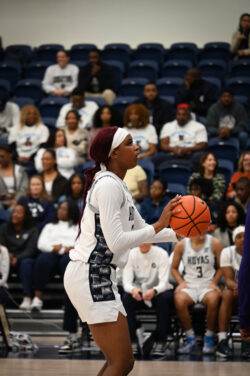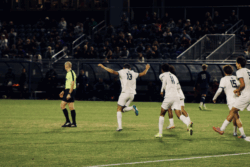Georgetown has won five games in row. That means they’re back, right? Or do the Hoyas have to win six in row to officially be “back”? What if they were never gone?
The team certainly wasn’t looking too good a couple of weeks ago—starting off 1-4 in the toughest conference in the country wasn’t ideal, to say the least. Many wondered how good this squad actually was. Would they be able to get back to their winning ways, or were they simply not talented enough to compete with the Big East elite? I admit, it’s a thought that crept into my head during the rough start.
Now they stand at 6-4, good for seventh in the Big East, and only a half-game out of second place. If the Hoyas were running to catch the bus a few weeks ago, I think it’s safe to say they are riding shotgun right now, with Pitt in the driver’s seat. This didn’t just happen though—it took a lot of work.
The turning point of Georgetown’s season was not a shot by Austin Freeman, or a block by Henry Sims. In fact, it didn’t even occur during a game. After the Hoyas strung together two wins in New Jersey against Rutgers and Seton Hall, they got a much needed week off. What they did with that week, the longest layoff they have all season, may very well have determined their success for the rest of the season.
It wasn’t easy for John Thompson III to get the team to start playing better after just one week of practice. He must have of done something special—something that has never been done before. Before we answer these questions, let’s step back and look at Thompson’s path this year.
He came into this season with a team dynamic that was different from all of his other years on the Hilltop. These Hoyas are guard-oriented, lacking the inside presence that defined the JTIII-era. Thompson proved he could adjust, as the backcourt carried the Hoyas to an 11-1 start. But coaches are not only judged during the preseason—they must be able to make in-season adjustments as well. That’s exactly what Thompson had to do after the slow Big East start. Lucky for him, he had more than a full week to correct the team. And JTIII passed the test with flying colors, putting the Hoyas in a great spot.
Thompson may have tried a number of things, but none of them were out of this world. Two things stick out. The first thing Thompson did, something he has always done well, was remain calm. He didn’t panic and institute a new system on offense or defense, or bench Freeman when his shooting went cold—he remained confident in his team’s abilities. Georgetown had a long climb ahead of them, but Thompson kept the team calm and focused on little things.
One of those things was the defense, which is certainly not a small part of basketball, but the way Thompson looked at it made it less of an obstacle. His simple approach made it manageable for players in a short period of time.
“At the end of the day, you got the ball and I’m guarding you and I gotta stop you. And we can sit and talk about we should do this zone and that zone, this pressure, that pressure … There’s no magic formula, no dust coach can sprinkle, or no dust my teammates can sprinkle to make that happen,” Thompson said back on Jan. 24, two days before the Hoyas beat St. John’s.
Thompson emphasized a lot of one-on-one and three-on-three drills during practice to get back to the basics of the game. The defensive effort has shown during the last three games. The Hoyas held all three of those opponents below a 41 percent field goal average, which is better than their season average. The intensity has risen as well, which might be the most promising sign for the rest of the season. There is no stat for defensive intensity, but it might be the most important measurement for a team’s success when you have a team as talented as the Hoyas.
Yes, the Hoyas still have eight games left in the Big East season, but they are in a totally different spot after their week off. They control their destiny. Sometimes, you have to get worse before you get better. I think it’s safe to say the Hoyas are back and better than ever.




